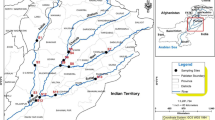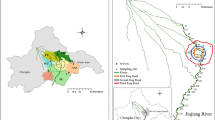Abstract
The occurrence of organohalogenated compounds including major persistent chlorinated pollutants, such as polychlorinated biphenyls (PCBs) and DDT and its metabolites, brominated flame retardants (BFRs), represented by polybrominated diphenylethers (PBDEs) and hexabromocyclododecane (HBCD), together with currently widely discussed perfluorinated compounds (PFCs), mainly perfluorooctane sulfonic acid was monitored in several fish species collected from Czech rivers. Eleven sampling locations in highly industrialized areas were chosen. In addition, wild species of 14 farmed fish (grown in dedicated ponds) were also analysed. With respect to the contamination in different areas, chlorinated chemicals were dominant. PCBs and DDTs ranged from 4.8 to 211 and 2 to 791 μg/kg wet weight, respectively. Concentrations of BFRs and PFCs were significantly lower and ranged from 0.6 to 10.2 and 0.9 to 62 μg/kg wet weight, respectively. The highest levels of target analyte groups were found in fish muscle tissue in localities situated on the lower part of the Elbe River: Levels of DDT, HCB, PBDEs, and perfluorooctane sulfonic acid (PFOS) were as high as 791, 77.6, 14.4 and 193 μg/kg wet weight, respectively, in Usti nad Labem and in the sample originated from the confluence of Elbe with Bilina River; a sum of PCBs at a level of 211 μg/kg was detected.






Similar content being viewed by others
References
The EFSA (2008) Perfluorooctane sulfonate (PFOS), perfluorooctanoic acid (PFOA) and their salts. Scientific opinion of the panel on contaminants in the food chain. ESFA J 653:1–131
Berger U, Glynn A, Holmström KE, Berglund M, Ankarberg EH, Törnkvist A (2009) Fish consumption as a source of human exposure to perfluorinated alkyl substances in Sweden―Analysis of edible fish from Lake Vättern and the Baltic Sea. Chemosphere 76:799–804
Bromine Science and Environmental Forum (2010) Available at: http://www.bsef.com/uploads/Documents/documents/BSEF_Deca–BDE_08–10f.pdf. Accessed 25 Nov 2010
Conder JM, Hoke RA, de Wolf W, Russell MH, Buck RC (2008) Are PFCAs bioaccumulative? a critical review and comparison with regulatory criteria and persistent lipophilic compounds. Environ Sci Technol 42:995–1003
Corsolini S, Covaci A, Ademollo N, Focardi S, Schepens P (2006) Occurrence of organochlorine pesticides (OCPs) and their enantiomeric signatures, and concentrations of polybrominated diphenyl ethers (PBDEs) in the Adélie penguin food web, Antarctica. Environ Pollut 140:371–382
Covaci A, Gheorghe A, Hulea O, Schepens P (2006) Levels and distribution of organochlorine pesticides, polychlorinated biphenyls and polybrominated diphenyl ethers in sediments and biota from the Danube Delta, Romania. Environ Pollut 140:136–149
de Boer J, Dao QT, van Leeuwen SPJ, Kotterman MJJ, Schobben JHM (2010) Thirty year monitoring of PCBs, organochlorine pesticides and tetrabromodiphenylether in eel from The Netherlands. Environ Pollut 158:1228–1236
Eljarrat E, Labandeira A, Marsh G, Raldúa D, Barceló D (2007) Decabrominated diphenyl ether in river fish and sediment samples collected downstream an industrial park. Chemosphere 69:1278–1286
Grabic R, Hansen LG, Ptak A, Crhova S, Gregoraszczuk EŁ (2006) Differential accumulation of low–chlorinated (Delor 103) and high–chlorinated (Delor 106) biphenyls in human placental tissue and opposite effects on conversion of DHEA to E2. Chemosphere 62:573–580
Hajšlová J, Pulkrabová J, Poustka J, Čajka T, Randák T (2007) Brominated flame retardants and related chlorinated persistent organic pollutants in fish from Elbe River and its main tributary Vltava. Chemosphere 69:1195–1203
Havelková M, Randák T, Žlábek V, Krijt J, Kroupová H, Pulkrabová J et al (2007) Biochemical markers for assessing aquatic contamination. Sensors 7:2599–2611
Hoekstra PF, O’Hara TM, Fisk AT, Borgå K, Solomon KR, Muir DCG (2003) Trophic transfer of persistent organochlorine contaminants (OCs) within an Arctic marine food web from the southern Beaufort–Chukchi Seas. Environ Pollut 124:509–522
Hrádková P, Poustka J, Hloušková V, Pulkrabová J, Tomaniová M, Hajšlová J (2010) Perfluorinated compounds: occurrence of emerging food contaminants in canned fish and seafood products. Czech J Food Sci 28:326–335
Isosaari P, Hallikainen A, Kiviranta H, Vuorinen PJ, Parmanne R, Koistinen J et al (2006) Polychlorinated dibenzo–p–dioxins, dibenzofurans, biphenyls, naphtalenes and polybrominated diphenyl ethers in the edible fish caught from the Baltic Sea and lakes in Finland. Environ Pollut 141:213–225
Jahnke A, Berger U (2009) Trace analysis of per–and polyfluorinated alkyl substances in various matrices―How do current methods perform? J Chromatogr 1216:410–421
Labadie P, Alliot F, Bourges C, Desportes A, Chevreuil M (2010) Determination of polybrominated diphenyl ethers in fish tissues by matrix solid–phase dispersion and gas chromatography coupled to triple quadrupole mass spectrometry: case study on European ell (Anguilla anguuilla) from Mediterranean coastal lagoons. Anal Chim Acta 675:97–105
Lacorte S, Raldúa D, Martínez E, Navarro A, Diez S, Bayona JM et al (2006) Pilot survey of a broad range of priority pollutants in sediment and fish from the Ebro river basin (NE Spain). Environ Pollut 140:471–482
Law RJ, Allchin CR, de Boer J, Covaci A, Herzke D, Lepom P, Morris S et al (2006) Levels and trends of brominated flame retardants in the European environment. Chemosphere 64:187–208
Li Z-H, Zlabek V, Turek J, Velisek J, Pulkrabova J, Kolarova J et al (2010) Evaluating environmental impact of STPs situated on streams in the Czech Republic: an integrated approach to biomonitoring the aquatic environment. Water Res 43:1403–1413
Macgregor K, Oliver IO, Harris L, Ridgway IM (2010) Persistent organic pollutants (PCB, DDT, HCH, HCB & BDE) in eels (Anguilla anguilla) in Scotland: Current levels and temporal trends. Environ Pollut 158:2402–2411
Nfon E, Cousins IT, Broman D (2008) Biomagnification of organic pollutants in benthic and pelagic marine food chains from the Baltic Sea. Sci Total Environ 397:190–204
Pulkrabová J, Hajšlová J, Poustka J, Kazda R (2007) Fish as biomonitors of polybrominated diphenyl ethers and hexabromocyclododecane in Czech aquatic ecosystems: pollution of the Elbe River Basin. Environ Health Perspect 115:28–34
Pulkrabová J, Hrádková P, Poustka J, Hajšlová J, Tomaniová M, Randák T (2008) Perfluorinated contaminants in the water ecosystem of the Czech Republic. Statistical environmental yearbook of the Czech Republic 2008. Ministry of the environment of the Czech Republic, Prague, Czech Republic, pp 415–422. ISBN: 80-7212-472-5
Qui Y-W, Zhang G, Guo L-L, Zheng GJ, Cai S-Q (2010) Bioaccumulation and historical deposition of polybrominated diphenyl ethers (PBDEs) in Deep Bay, South China. Mar Environ Res 70:219–226
Randák T, Žlábek V, Kolářová J, Svobodová Z, Hajšlová J, Široká Z et al (2006) Biomarkers detected in chub (Leuciscus cephalus L.) to evaluate contamination of the Elbe and Vltava Rivers, Czech Republic. Bull Environ Contam Toxicol 76:233–241
Roosens L, Dirtu AC, Goemans G, Belpaire C, Gheorghe A, Neels H et al (2008) Brominated flame retardants and polychlorinated biphenyls in fish from the river Scheldt, Belgium. Environ Int 36:976–983
Schmid P, Kohler M, Gujer E, Zennegg M, Lanfranchi M (2007) Persistent organic pollutants, brominated flame retardants and synthetic musks in fish from remote alpine lakes in Switzerland. Chemosphere 67:16–21
Stockholm Convention on Persistent Organic Pollutants (POPs) (2001) What are POPs? Available at: http://chm.pops.int/Convention/The%20POPs/tabid/673/language/en–US/Default.aspx. Accessed 9 April 2010
Stockholm Convention on Persistent Organic Pollutants (POPs) (2009) Endosulfan included under the convention. Available at: http://chm.pops.int/default.aspx. Accessed: 9 April 2010
Svobodová Z, Žlábek V, Randák T, Machová J, Kolářová J, Hajšlová J et al (2003) Profiles of persistent organochlorine pollutants (POPs) in tissues of marketable common carp and in bottom sediments of selected ponds of South and West Bohemia. Acta Vet Brno 72:295–309
Ueno D, Alaee M, Marvin Ch, Muir DCG, Macinnis G, Reiner E et al (2006) Distribution and transportability of hexabromocyclododecane (HBCD) in the Asia–Pacific region using skipjack tuna as a bioindicator. Environ Pollut 144:238–247
United States Environmental Protection Agency (2009) Persistent organic pollutants (POPs). Available at: http://www.epa.ie/whatwedo/resource/hazardous/pops/. Accessed 13 Oct 2010
van Leeuwen SPJ, de Boer J (2008) Brominated flame retardants in fish and shellfish―Levels and contribution of fish consumption to dietary exposure of Dutch citizens to HBCD. Mol Nutr Food Res 52:194–203
van Leeuwen SPJ, van Velzen MJM, Swart CP, van der Veen I, de Boer J, Traag WA (2009) Halogenated contaminants in farmed salmon, trout, tilapia, pangasius, and shrimp. Environ Sci Technol 43:4009–4015
Vávrová M, Šucman E, Páč J, Zlámalová–Gargošová H, Stoupalová M, Jirušková J et al (2003) Assessing contamination levels in a reservoir on the basis of the determination of xenobiotics in fish. Fresen Environ Bull 12:901–905
Acknowledgments
This research was supported by the EU Research Project CONffIDENCE (FP7–211326–CP and 7E08068), by the Ministry of Education, Youth and Sports of the Czech Republic (MSM 6046137305) and the Research Support Fund of the National Training Fund within the project EMERCON (No. A/CZ0046/2/0026 and 7E09075).
Author information
Authors and Affiliations
Corresponding author
Rights and permissions
About this article
Cite this article
Hrádková, P., Pulkrabová, J., Kalachová, K. et al. Occurrence of Halogenated Contaminants in Fish from Selected River Localities and Ponds in the Czech Republic. Arch Environ Contam Toxicol 62, 85–96 (2012). https://doi.org/10.1007/s00244-011-9681-z
Received:
Accepted:
Published:
Issue Date:
DOI: https://doi.org/10.1007/s00244-011-9681-z




